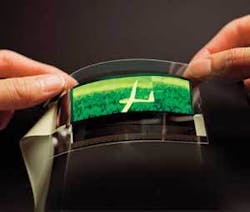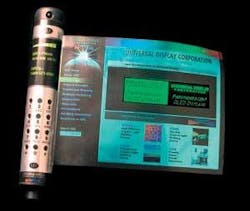Universal Display to provide portable flexible communications device to Navy
By John McHale
EWING, N.J. - The U.S. Navy awarded Universal Display Corp. in Ewing, N.J., a contract to provide a prototype communications device based on a full-color, active-matrix organic-light-emitting-diode (OLED) prototype built on metallic foil.
This Navy funding leverages work that Universal Display is performing for the U.S. Army and Air Force under a Small Business Innovation Research (SBIR) Phase III contract that the company announced in January 2006.
“This contract underscores the applicability of our flexible OLED technology to multiple branches of the Armed Services,” says Steven V. Abramson, president and chief operating officer of Universal Display Corp. By working with multiple military services we are also able to “accelerate the commercialization of our flexible OLED technology for portable electronic products for military as well as consumer uses.”
Under terms of the contract, Universal Display engineers will deliver an active-matrix PHOLED display prototype built on flexible metallic foil integrated into a wrist-worn wireless communication device. This prototype is enabled by the company’s proprietary PHOLED phosphorescent OLED, flexible OLED (FOLED), and TOLED or top-emission OLED technologies.
The display will be built on flexible metal foil to provide flexibility, light weight, and ruggedness and will use poly-silicon backplane technology from Palo Alto Research Center (PARC) in Palo Alto, Calif. The prototype will then be integrated into a wrist-mounted wireless device by L-3 Communications Display Systems in Alpharetta, Ga.
Universal Display calls its commercial version of this technology the Universal Communication Device, which will be a compact cell-phone-like communication device with a roll-out FOLED display that offers low-power, full-color, and full-motion video capabilities-to provide end users with advanced voice and data communication capabilities. The military programs emphasize the development of key components needed to realize the device, company officials say.
The U.S. Army Communications-Electronics Research and Development Engineering Center (CERDEC) is the contracting authority on Universal Display’s Army contract.
Under the CERDEC contract, Universal Display engineers are developing and demonstrating an active-matrix, flexible PHOLED display containing infrared (IR)-emitting PHOLED pixels in addition to visible spectrum PHOLED pixels.
The Company’s IR-emission OLED technology is being designed to be seen only through night-vision goggles so to avoid visual detection in darkness. By combining IR-emitting and visible PHOLED pixels into one display, the company is creating a display architecture to meet the Army’s requirement for a single, high-information-content display that works in high, low, and no light conditions, Universal Display officials say.
As a continuation from the Phase I program, University of Southern California will develop novel PHOLED materials for evaluation in the prototype.
The PHOLED technology provides a number of compelling advantages for the Army’s application needs, including superior power efficiency and clarity, longer lifetimes, lighter weight, and flexibility, Abramson says.
An OLED is a monolithic, solid-state device that typically consists of a series of organic thin films sandwiched between two thin-film conductive electrodes. The choice of organic materials and the layer structure determine the device’s performance features: emitted color, operating lifetime and power efficiency.
Universal Display Corporation’s FOLED flexible OLEDs are organic light-emitting devices that are built on flexible substrates such as plastic or metallic foil. FOLED displays can offer significant performance advantages over LCD (liquid-crystal display) displays that are typically built on rigid glass substrates and contain a bulky backlight, company officials say.
FOLEDs are thinner and lighter weight than other displays, which means that cell phones, portable computers, wall-mounted televisions, and other products that use them can also be lighter and smaller. They can also be more durable -less breakable and more impact resistant-than other displays, company officials say. With glass breakage a major cause of display-containing product returns, this is a highly desirable commercial alternative.
FOLEDs may be manufactured on a variety of substrates. FOLEDs built on optically-clear plastic films and thin, bendable metallic foils are currently under development at Universal Display. Such displays can be made to bend, flex, and conform to many surfaces. For example, FOLEDs may someday be found affixed to curved helmet face shields, shirtsleeve cuffs, and automotive instrument panels. The potential flexibility of FOLEDs may also enable the realization of Universal Display’s proprietary Universal Communication Device.
In the meantime, earlier-generation FOLEDs may provide limited conformability for applications that include a cell phone that conforms to the shape of your hand or a portable DVD player that has a curved surface to enhance the audience’s viewing experience.
FOLED technology opens up prospects for high-throughput, roll-to-roll processing (R2R) of OLEDs in the future, providing the basis for low-cost mass production, Abramson says.
Universal Display develops and commercializes OLED technologies and materials for use in the electronic flat panel display, lighting, and other opto-electronic markets. For more information please visit www.universaldisplay.com.


